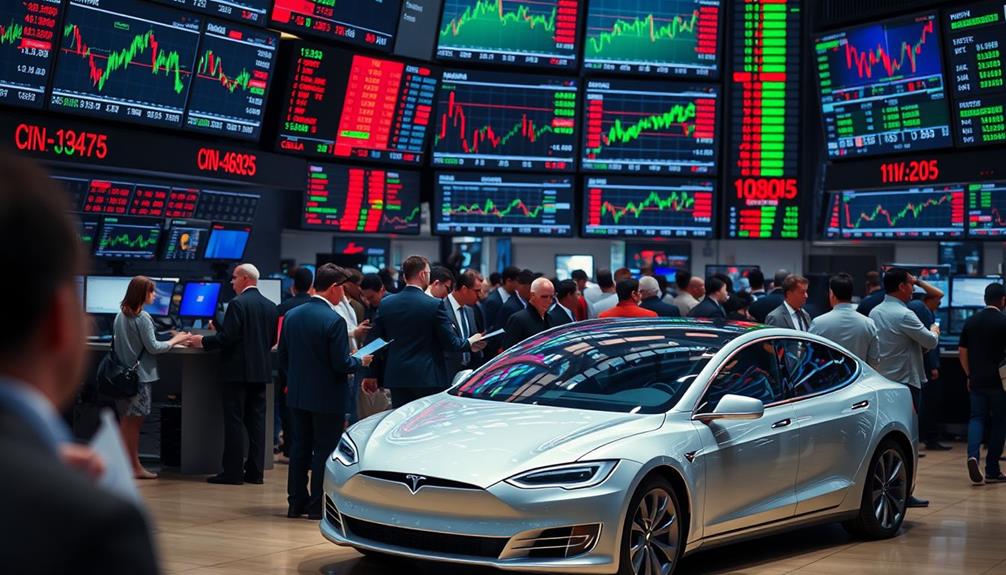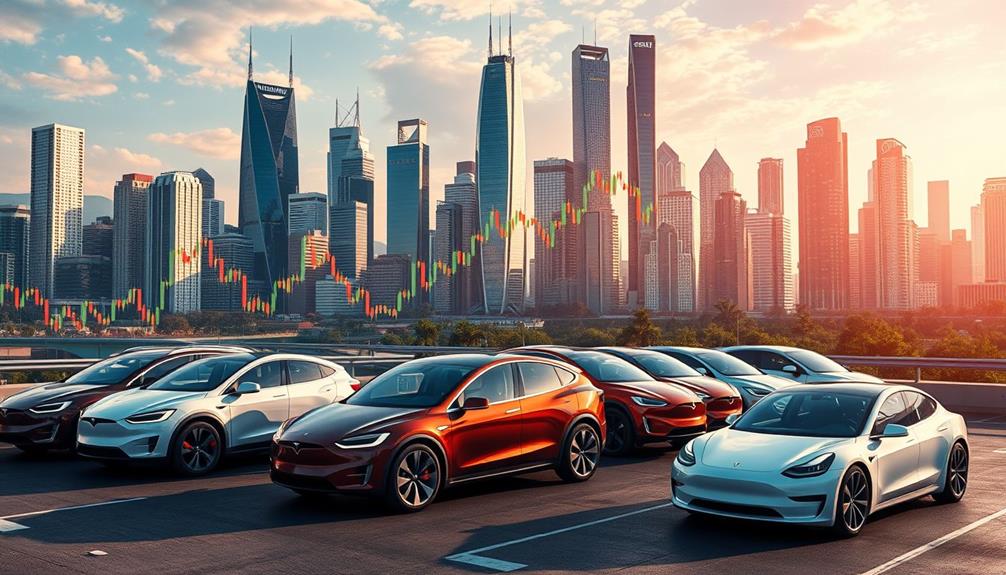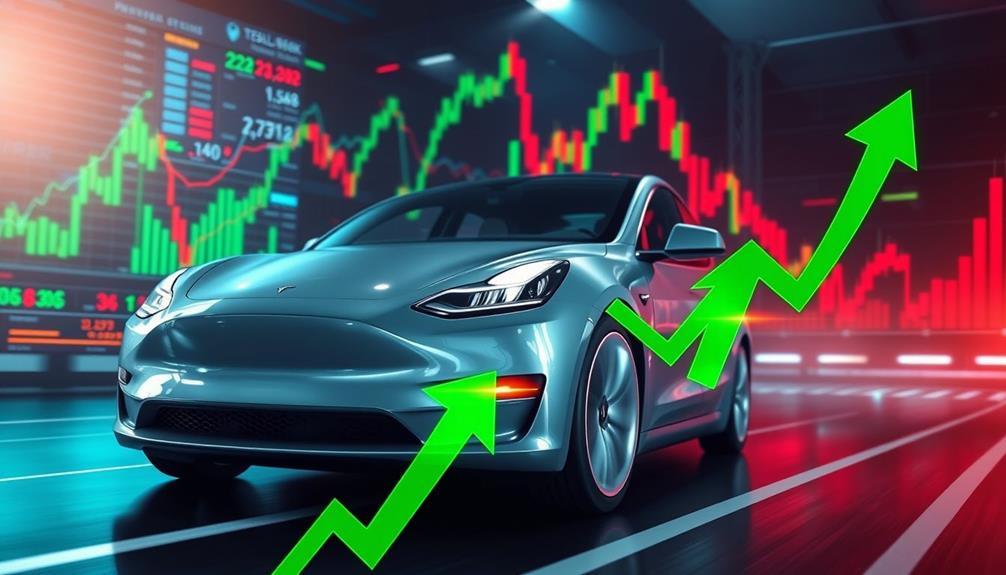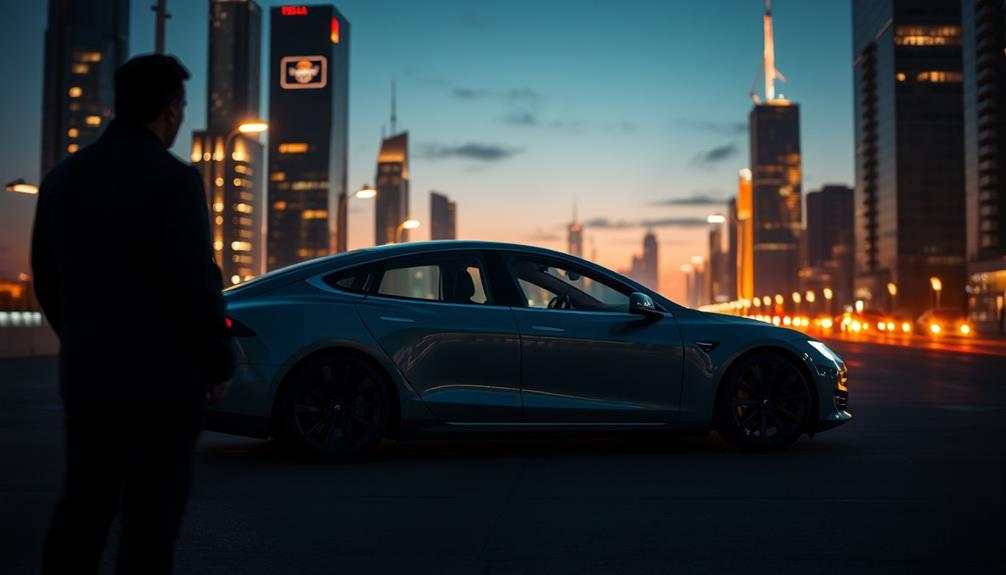Tesla stock is currently a mixed bag, with recent declines raising concerns. It's down 12% year-to-date, and analysts predict a 28% drop in earnings per share for 2024. Yet, the upcoming Robotaxi reveal in October could change the game, as it's projected to weigh heavily on Tesla's future value. Some analysts, like those at Morgan Stanley, see a potential 40% upside despite the risks. You'll want to assess how Tesla's competitive position and regulatory challenges might impact your investment before making a decision, especially with exciting developments on the horizon.
Key Takeaways
- Tesla stock has declined 12% year-to-date and 20% since July 2024, signaling potential risks for investors.
- Upcoming Robotaxi reveal on October 10, 2024, is crucial for long-term growth and could influence stock price significantly.
- Analysts project a 28% decline in EPS for 2024, which raises concerns about Tesla's financial trajectory.
- Increased competition and regulatory challenges, including tariffs and recalls, may impact Tesla's market position and profitability.
- Positive analyst sentiment remains, with Morgan Stanley projecting a 40% upside, suggesting potential recovery for the stock.
Tesla Stock Performance Overview

Tesla's stock performance has been a rollercoaster ride lately, with shares down about 12% year-to-date and facing a 20% decline since hitting their July 2024 highs. The company recently reported its Q2 2024 earnings, which fell 43% to 52 cents per share. Despite the dip in earnings, Tesla remains a key player in the electric vehicle market, continuing to innovate with new models and expansions. Investors are closely watching for signs of recovery, but many wonder, “does Tesla pay dividends?” Currently, Tesla does not offer dividends, focusing instead on reinvesting profits to fuel further growth and innovation.
While that sounds alarming, revenue slightly increased to $25.5 billion, surpassing analysts' expectations despite the drop in earnings.
Looking ahead, analysts predict a significant decrease in earnings per share for 2024, estimating it at $2.24—down 28% from the previous year's $3.12. This projected decline raises questions about Tesla's growth potential and overall stock performance.
Despite these challenges, Tesla's stock has shown resilience, rebounding approximately 60% from late-April lows. However, it struggles to maintain support at the 50-day moving average, signaling potential volatility ahead.
Currently, Tesla ranks third in the IBD Auto Manufacturers industry group, holding a Composite Rating of 67, which reflects moderate investor sentiment compared to its peers. Given these factors, you'll want to keep a close eye on Tesla's stock as you decide whether it aligns with your investment strategy.
Recent Earnings Analysis

Tesla's Q2 earnings report shows a 43% drop in earnings per share, coming in below analyst expectations.
Despite a revenue increase, the declining gross margins suggest that maintaining profitability is becoming tougher.
Looking ahead, projections for 2024 indicate a further decline in earnings, raising questions about the company's financial trajectory.
Q2 Earnings Overview
In the wake of Q2 earnings, investors faced disappointment as earnings fell by 43% year-over-year to 52 cents per share, missing analysts' expectations of 61 cents.
Despite a slight revenue increase of 2% to $25.5 billion, the decline in earnings per share notably impacted investor sentiment. The company's gross margins also took a hit, decreasing by 23 basis points to 18%, with auto gross margins specifically at 15.1%.
This underperformance led to a negative reaction in the market, resulting in a 7.7% drop in Tesla's stock price in August.
The outlook for 2024 isn't looking much better, with projections estimating a further decline in earnings per share to $2.24, marking a 28% decrease from the 2023 figure of $3.12.
Additionally, Tesla currently ranks third in the IBD Auto Manufacturers industry group with a Composite Rating of 67, reflecting mixed market performance following the latest earnings report.
As you assess Tesla's stock, it's essential to weigh these factors and consider how they align with your investment strategy.
Future Earnings Projections
Following the disappointing Q2 earnings report, it's important to look ahead at future earnings projections for Tesla. Analysts project the company's earnings per share (EPS) will drop to $2.24 in 2024, which is a concerning 28% decline from 2023's EPS of $3.12. This decline highlights the ongoing challenges Tesla faces in maintaining profitability amidst increasing costs and competitive pressures.
Despite a slight revenue growth of 2% year-over-year, the reduction in gross margins to 18%—with auto gross margins at just 15.1%—indicates that profitability is under strain.
Investors reacted negatively to the recent earnings news, leading to a notable 7.7% drop in Tesla's stock price in August 2024.
To navigate these challenges, Tesla needs to focus on cost management and innovation to sustain its market position. If the company can effectively address these issues, future earnings projections could improve.
However, as it stands, investor sentiment remains cautious. It's essential for you, as an investor, to monitor how Tesla responds to these challenges moving forward before making any decisions on whether to buy or hold.
Robotaxi Developments and Expectations

Tesla's upcoming Robotaxi revelation on October 10, 2024, is generating buzz as investors evaluate its potential impact on the company's stock.
With projections estimating that the Robotaxi business could account for 90% of Tesla's enterprise value by 2029, you'll want to think about how this could shift your investment strategy.
However, keep an eye on market competition and the challenges that lie ahead as Tesla pushes forward with this ambitious initiative.
Upcoming Robotaxi Unveiling Date
Anticipation is building for the disclosure of Tesla's Robotaxi, now set for October 10, 2024, after a delay from its initial date of August 8. This extra time allows for design improvements, underscoring Tesla's commitment to delivering a superior product.
Elon Musk has pledged $10 billion in 2024 to enhance AI training and infrastructure, specifically aimed at optimizing the Robotaxi's ride-hailing capabilities.
Ark Invest has been vocal about the significance of the upcoming robotaxi disclosure date, projecting that Tesla's enterprise value will hinge on the success of this venture. If the Robotaxi initiative flourishes, Ark Invest estimates a price target of $2,600 per share by 2029.
However, they also warn that without a successful robotaxi network, this target could drop dramatically to $350 per share.
This stark contrast highlights the critical importance of the Robotaxi project for Tesla's future. As confidence builds in the launch of the robotaxi service within the next five years, many investors are maintaining a long-term bullish outlook on Tesla's autonomous driving initiatives, setting the stage for potential growth.
Financial Projections and Impact
The anticipated launch of Tesla's Robotaxi service is poised to markedly impact the company's financial projections and overall valuation.
With Elon Musk allocating $10 billion for AI training and improvements aimed at enhancing this service, it's clear that this initiative is vital for Tesla's future. The revelation has been postponed to October 10, 2024, reflecting the importance of getting the design right before launch.
Investors should note the following:
- Ark Invest predicts that by 2029, 90% of Tesla's enterprise value could hinge on the robotaxi business.
- If successful, the price target could soar to $2,600 per share; however, without the robotaxi network, estimates suggest a potential drop to $350.
- Confidence in launching the robotaxi service within five years signals a long-term bullish outlook for Tesla's autonomy efforts.
Market Competition and Challenges
As the robotaxi service draws closer to its launch date, the competitive landscape in the autonomous vehicle market becomes increasingly intense.
Tesla's revelation has been postponed to October 10, 2024, which demonstrates the company's commitment to refining its technology. This delay could impact Tesla's market competition, especially as rivals accelerate their advancements in self-driving capabilities.
Elon Musk's $10 billion investment in AI training and infrastructure aims to enhance the ride-hailing functionality of Tesla's robotaxi initiative.
If successful, Ark Invest predicts that by 2029, 90% of Tesla's enterprise value will tie to this robotaxi business, potentially elevating the stock price to $2,600 per share. However, without the robotaxi's success, estimates drop to just $350.
While confidence in launching the robotaxi service within five years suggests a bullish outlook on Tesla's autonomy initiatives, you should consider that delays could hinder its competitive edge.
Rivals like Uber and Lyft are also improving their self-driving technologies, intensifying the race for market dominance.
As an investor, it's essential to keep these factors in mind when evaluating Tesla's future potential.
Upcoming Vehicle Production Plans

Tesla's upcoming vehicle production plans are generating buzz among investors and consumers alike. As you keep an eye on the market, it's vital to note that the company is aiming to mass-produce a more affordable model, previously referred to as Model 2, by the first half of 2025.
However, there are whispers that this model might be scrapped altogether.
While Tesla anticipates vehicle volume growth for 2024, it's projected to be lower than in 2023, creating potential challenges in meeting market demand.
Significantly, Q3 2024 delivery estimates project 458,000 units, reflecting a modest 5% year-over-year growth despite the overall decline in vehicle volume growth.
To help you understand Tesla's direction, consider these key points:
- Upcoming production of upgraded Model Y and Cybertruck models is expected to boost consumer interest.
- The focus on diversifying production plans includes a rapidly growing energy storage business.
- Maintaining market competitiveness will require adapting to evolving consumer preferences.
These production plans could play an important role in Tesla's performance as you evaluate its stock potential.
Regulatory Challenges Impacting Tesla

In light of ongoing regulatory challenges, Tesla faces significant hurdles that could impact its market performance. The company is currently grappling with a 9% tariff on vehicles imported from China to the EU, coupled with a 10% tariff on all foreign-made cars. This affects its pricing strategy and competitiveness in the European market. Additionally, Tesla has been under scrutiny for over seven years regarding faulty suspension and steering parts, with investigations in Norway and Sweden specifically targeting the Model S and X vehicles.
Moreover, the NHTSA's recent over-the-air recall affecting over 2 million Tesla vehicles due to Autopilot misuse adds another layer of regulatory scrutiny over its self-driving technologies. These challenges create uncertainties that can erode investor confidence and inflate operational costs for Tesla moving forward.
| Regulatory Issue | Impact on Tesla |
|---|---|
| Tariffs on imported vehicles | Increased pricing pressures |
| Investigations on vehicle parts | Potential recalls and repairs |
| NHTSA recall of Autopilot | Higher scrutiny on safety |
As these regulatory challenges persist, you'll want to keep a close eye on how they affect Tesla's overall market strategy and performance.
Investor Sentiment and Market Dynamics

Investor sentiment around Tesla has been quite volatile lately, reflecting broader market dynamics and the company's recent performance. The stock has plummeted 12% year-to-date and 20% since its July 2024 highs, primarily due to disappointing Q2 earnings.
However, a recent rebound of about 20% over the past month shows that not all hope is lost.
As you navigate your investment decisions, consider these factors:
- Analysts anticipate a 28% decline in earnings per share for 2024, raising concerns.
- Morgan Stanley's bullish outlook identifies Tesla as a top pick, projecting a potential 40% upside.
- The upcoming Robotaxi revelation on October 10 could greatly sway investor sentiment and market dynamics.
Despite the challenges, advancements in self-driving technology and strong delivery estimates support a more positive outlook.
Q3 projections indicate a 5% year-over-year growth in deliveries, reaching 458,000 units. Ark Invest even set a TSLA price target of $2,600 by 2029, which could fuel optimism.
Analyst Recommendations and Insights

Analysts are closely watching Tesla as it navigates a challenging landscape, and their recommendations reflect a mix of caution and optimism.
Morgan Stanley recently named Tesla its top pick in the U.S. auto sector, projecting a considerable 40% upside for TSLA stock. This positive outlook comes despite analysts forecasting a decline in earnings per share for 2024, estimating it to be $2.24, down from $3.12 the previous year. This signals a cautious sentiment among experts.
Interestingly, Tesla's stock has rebounded about 20% over the past month after a 12% decline year-to-date, indicating potential recovery confidence among investors.
The IBD Auto Manufacturers industry group ranks Tesla third with a Composite Rating of 67, suggesting moderate strength compared to its peers.
Looking ahead, analysts emphasize the importance of the upcoming Robotaxi reveal on October 10. This event could considerably influence future stock performance and investor sentiment, making it a key date for those considering an investment in TSLA stock.
Corporate Governance and Leadership

When you look at Tesla's corporate governance, Elon Musk's influence stands out, especially after shareholders approved his $56 billion pay package.
His push for increased voting power shows his intent to steer the company's strategy, particularly in AI and robotics.
Balancing his control with shareholder interests is essential as Tesla navigates the competitive landscape of the tech-driven automotive sector.
Musk's Voting Power Influence
While Musk's substantial influence over Tesla's corporate governance is evident, his recent moves to enhance his voting power raise important questions about the balance between leadership authority and shareholder interests.
With nearly 13% of Tesla's shares, down from 22% before his Twitter acquisition, Musk seeks to increase his voting power to 25%. This shift would give him greater authority over vital decisions in AI and robotics.
Musk's ambition to solidify his control reflects broader market dynamics and poses potential risks and rewards.
Consider these implications:
- Strategic Control: Increased voting power could lead to more cohesive decision-making, aligning Tesla's direction with Musk's vision.
- Shareholder Concerns: His growing influence may raise alarms among shareholders about the concentration of power, potentially affecting their trust.
- Innovation vs. Risk: While his leadership is often a catalyst for innovation, excessive control might stifle diverse perspectives and challenge the company's adaptability.
Ultimately, understanding Musk's voting power influence is essential for evaluating Tesla's long-term prospects and determining whether it aligns with your investment strategy.
Shareholder Approval Dynamics
Steering the dynamics of shareholder approval is vital for understanding Tesla's corporate governance and leadership landscape. Recently, shareholders showed strong confidence in Elon Musk's leadership by approving his $56 billion pay package, indicating their belief in his vision for Tesla's future. This approval reflects a positive endorsement amidst Musk's efforts to enhance his control over the company, particularly as he seeks to increase his voting power to 25%.
Musk currently holds about 13% of Tesla's shares, down from 22% after his Twitter acquisition, which highlights a notable shift in his ownership stake. The recent approval for Tesla's reincorporation in Texas aligns with his strategy to operate in a more business-friendly environment.
However, the dynamics of shareholder approval also underscore the balance between Musk's control and the influence of other shareholders. While Musk's ambitions to steer Tesla's direction in AI and robotics are ambitious, the voice of the shareholders remains essential in corporate governance decisions.
As you consider investing in Tesla, keep an eye on how these dynamics evolve, as they can greatly impact the company's strategic path and, ultimately, its stock performance.
Corporate Strategy and Control
Understanding Tesla's corporate strategy and control is key to grasping its future direction. The company's governance reflects a delicate balance between Elon Musk's influence and shareholder interests. Recently, shareholders reaffirmed their confidence in Musk by approving his substantial pay package and the relocation to Texas. This move signals strong backing for his vision, despite Musk's efforts to regain greater voting control after his shareholding decline.
Key elements of Tesla's corporate governance strategy include:
- Balancing Control: Maintaining agility while addressing investor concerns about Musk's influence.
- Strategic Innovation: Focusing on risk management in artificial intelligence and robotics for long-term growth.
- Navigating Challenges: Proactively addressing regulatory and competitive landscapes in the evolving electric vehicle market.
Musk holds nearly 13% of Tesla's shares, and his quest to regain more influence underscores the ongoing dynamics between his leadership and shareholder governance.
As Tesla maneuvers through a rapidly changing industry, understanding this corporate strategy will help you evaluate the stock's potential and its alignment with your investment goals.
Competitive Landscape and Market Position

In today's dynamic electric vehicle market, Tesla's competitive landscape is becoming increasingly challenging. Despite ranking third in the IBD Auto Manufacturers industry group with a Composite Rating of 67, the company faces intensified competition from established automakers rapidly rolling out their electric models. This could threaten Tesla's market position and overall share.
Here's a brief look at some key factors affecting Tesla's competitive stance:
| Factor | Impact on Tesla | Notes |
|---|---|---|
| Analyst Confidence | Positive | Morgan Stanley projects a 40% upside for TSLA stock. |
| Import Tariffs | Moderate | EU's 9% tariff on Tesla vehicles from China is better than competitors. |
| Vehicle Volume Expectations | Negative | Expected growth is lower than previous years, signaling market challenges. |
While Morgan Stanley's optimistic Tesla stock price target reflects confidence, the hurdles from competition and tariffs may weigh heavily on the company's future. Investors should pay close attention to these dynamics as they navigate the evolving landscape.
Future Projections for Tesla Stock

Tesla's future projections paint a mixed picture for investors. While the long-term outlook for Tesla remains bullish, with expectations for growth driven by new model releases and advancements in full self-driving technology, there are also challenges on the horizon.
Analysts expect earnings per share to decline to $2.24 in 2024, a worrying 28% drop from 2023.
Key considerations for you include:
- Q3 2024 delivery estimates predict 458,000 units, indicating a slight slowdown in growth.
- Ark Invest's ambitious price target of $2,600 by 2029 hinges on the successful rollout of the robotaxi business, expected to contribute considerably to Tesla's enterprise value.
- The production of an affordable vehicle is slated for the first half of 2025, which could enhance Tesla's market share in the competitive EV segment.
As you evaluate the future projections for Tesla stock, weigh these factors carefully. Although the potential for recovery exists through innovative releases, short-term hurdles could impact your investment strategy.
Stay informed, as Tesla continues to shape the electric vehicle landscape.
Frequently Asked Questions
Is Tesla a Good Stock to Buy Right Now?
When considering Tesla, you should weigh its recent performance and volatility against future growth potential. Analyzing upcoming product launches and delivery estimates can help you decide if it aligns with your investment strategy.
What Is the Prediction for Tesla Stock?
Imagine steering through a vast ocean; Tesla's stock is the ship. Predictions suggest turbulent waters ahead, with earnings set to dip. Yet, the horizon shows promise, especially if new models and robotaxis sail smoothly into view.
What Is the Prediction for Tesla in 2024?
In 2024, you'll see Tesla facing earnings challenges with a projected 28% decline. However, vehicle volume growth and energy storage expansion might offer some upside, while the Robotaxi initiative could greatly impact long-term value.
Why Are Tesla Stocks Going Down?
You see Tesla stocks sliding due to disappointing earnings, shrinking margins, and looming regulatory challenges. As market confidence wanes, a projected EPS drop for 2024 adds to the uncertainty surrounding the company's financial future.
Conclusion
As you weigh whether Tesla stock is a buy right now, consider this: can you afford to miss out on the electric revolution? With promising earnings, innovative developments like robotaxis, and a solid market position, Tesla's future looks bright. However, keep an eye on regulatory hurdles and competition. Ultimately, the decision rests with you, but the potential for growth in this dynamic landscape is hard to ignore. Are you ready to take the leap?










